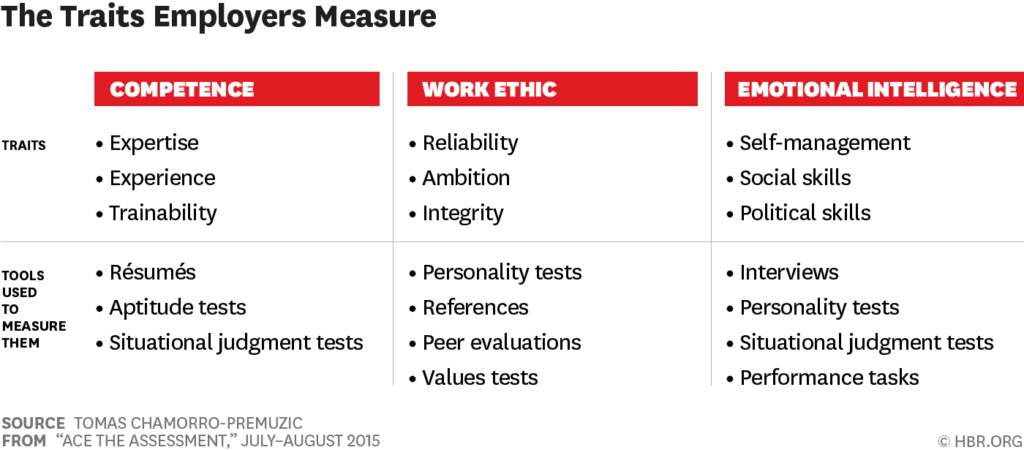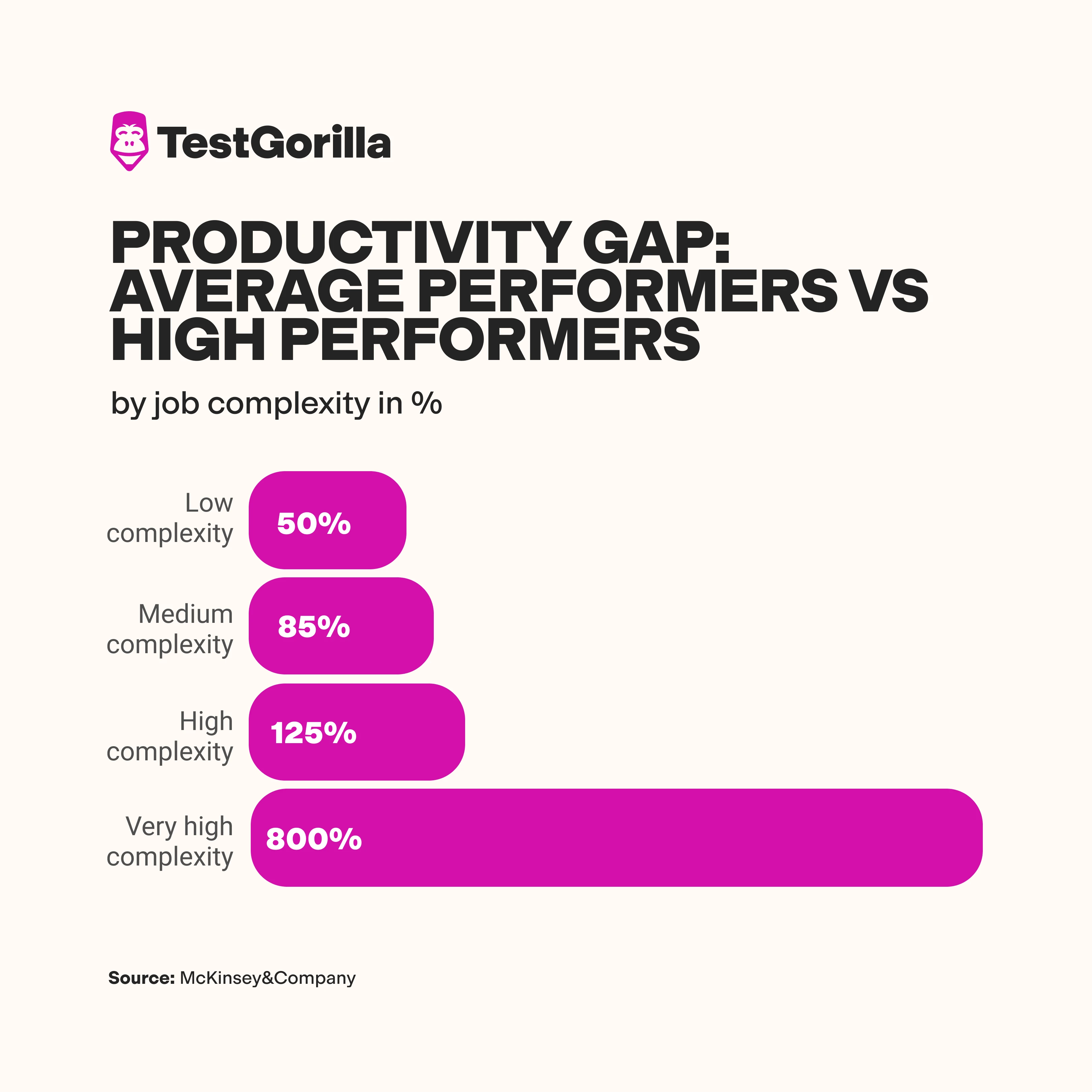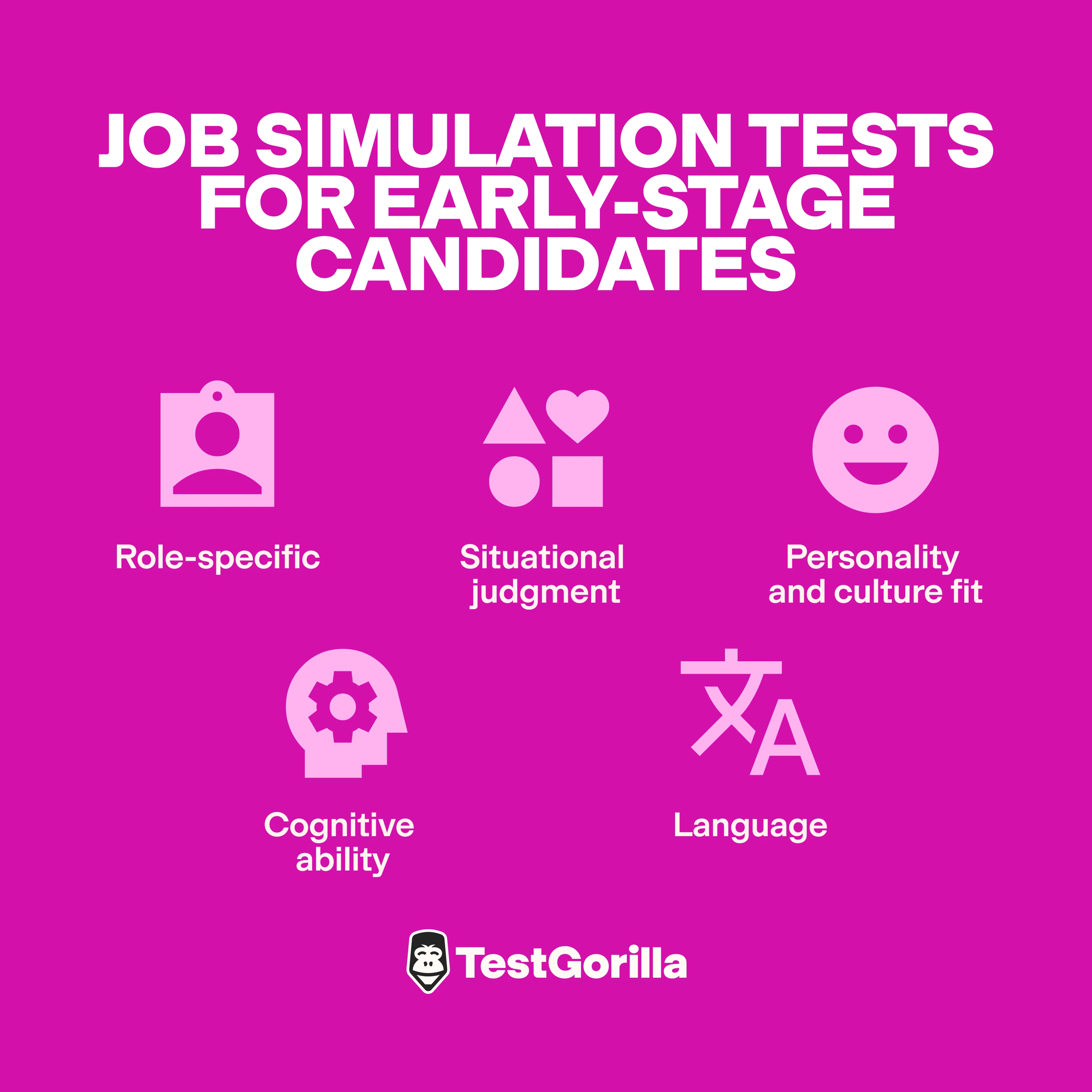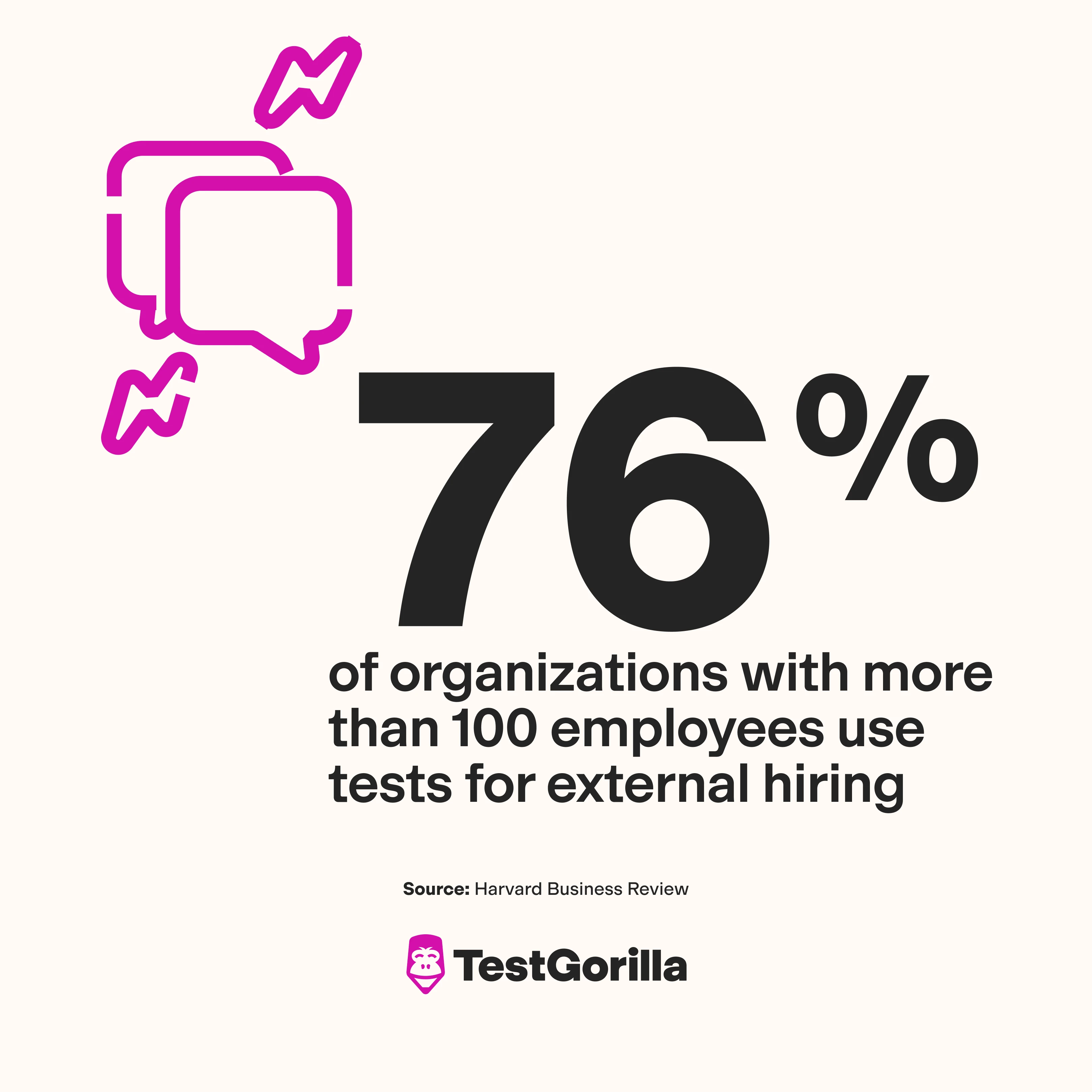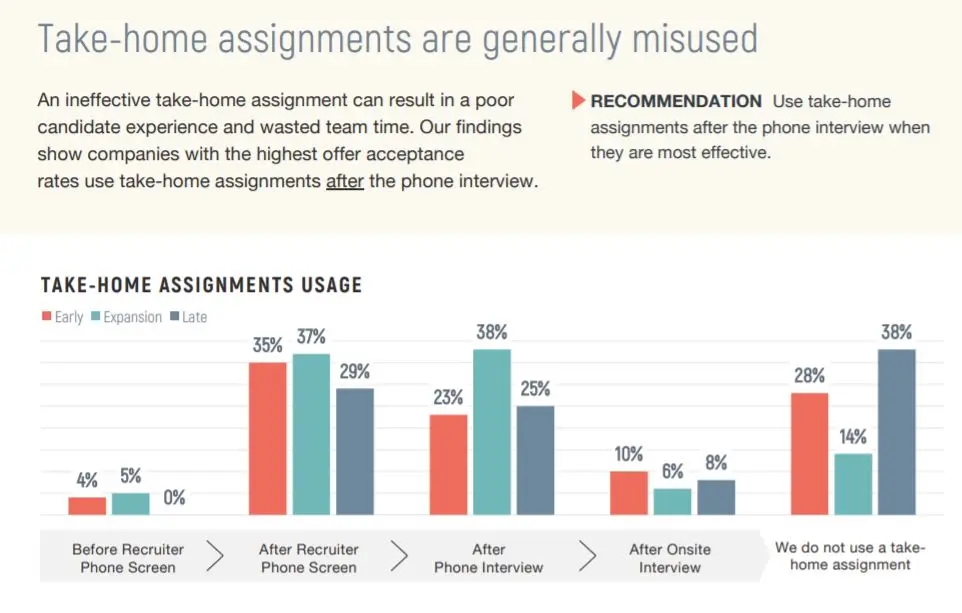Hiring the most qualified candidate for a job often feels like trying to catch that one specific raindrop in a deluge. With hundreds if not thousands of CVs pouring in for every open position offering self-produced assessments of candidates’ skills and abilities, it’s nearly impossible (and extremely time-consuming) to know who the most qualified candidates are.
The one thing that can help you filter through all that to find the perfect fit? Job simulations.
A job simulation is a test that helps you assess a candidate’s skills in the tasks they will be performing on a daily basis in the role they’re applying for. You can use different types of job simulations at different stages of your hiring process to evaluate specific aspects of candidates’ abilities in an objective and measurable way so you can hire the best person for the job and your team.
In this post, were going to talk about how job simulations help you make the best hiring decisions, review the three different types of job simulations you can use at the different stages of your hiring process, and discuss how best to prepare both your candidates and your team for successful job simulations that provide the best results. Let’s dive in!
Table of contents
- How job simulations help you hire the best
- Ensure team fit through a realistic job preview
- Job simulation type 1: screening tests for early-stage candidates
- Job simulation type 2: take-home assignments after the first call
- Job simulation type 3: live exercises at the decision-making stage
- How to prepare candidates and your team for successful job simulations
- With job simulations, you can be confident you’ve hired the best candidate for the job
How job simulations help you hire the best
Over the years, job simulations have been developed to create more effective recruitment processes that benefit organizations.
“76 percent of organizations with more than 100 employees use tests for external hiring.”
They use these tests to measure different traits that can identify important qualities workers should have, such as, competence, work ethic and emotional intelligence.
Candidates can take job simulation tests online, in an assessment center or over the phone.
The candidate is put in an environment where he or she will have the opportunity to carry out tasks that would be part of their daily routine in the business.
The tasks can be as simple as typing a certain number of words per second or solving math problems, as well as more complex tasks, such as developing a budget, writing code or drafting a marketing strategy.
Here are some important benefits that job simulations offer.
Make better decisions with high predictive validity
Your goal is to hire people who can perform at their jobs, not candidates who show incredible abilities to sell themselves on paper. Cover letters and resumes can become subjective and difficult to trust.
Candidates now have access to paid services for resumes and cover letters and generously boast about their skills and abilities.
A guaranteed way to objectively evaluate candidates is by using job simulations. Here, you will less likely be swayed by attractive words and elaborate examples of past successful projects. Instead, you will assess each candidate the same way by seeing how well they can handle the job at hand.
By creating scenario tests based on real life in the business, candidates can showcase how well they can handle working for you and in the position.
Situational judgment tests scores can be used to rank candidates. You can rely on this quantitative data to predict which candidate will be successful at the job.
Discover the strongest candidates through increased objectivity
Job simulations offer you an objective way to assess candidates and pick the best one. This helps with managing unconscious biases.
Unfortunately, we cannot completely eliminate unconscious bias. Even without knowing it, you risk discriminating against candidates based on skin color, gender, age, height, weight, religion, disability status or even where they were educated.
The costs of missing out on the best candidate are high. In fact, according to McKinsey senior partners Scott Keller and Mary Meaney, superior talent can be 8 times more productive than an average hire!
Using job simulations can help you mitigate the risks of unconscious bias in your recruitment, thus allowing you to find that superior talent you were looking for.
Improve the ROI on your hiring process through lower costs
Time spent in reading resumes, short-listing candidates, interviewing and on-boarding can easily add up. On top of that, if the wrong candidate is recruited and has to be replaced, the cost involved is much higher than you think.
Here are some key stats about the cost of a bad hire:
The U.S. Department of Labor states that the cost of a bad hire is up to 30 percent of an employee’s first year income.
A 2014 study by Robert Half International showed that 34 percent of CFOs interviewed believed that bad hiring results in loss of productivity. In the same study, 39 percent of CFOs agreed that bad hires cause a decrease in general staff morale.
According to a 2017 CareerBuilder survey, 74 percent of recruiters admitted to hiring the wrong person resulting in an average cost of $14,900 for every bad hire.
The Undercover Recruiter reported that bad hires can cost up to $240,000 in expenses.
Job simulations minimize these costs and risks, reducing the labor hours, brainpower and stress to the business.
Ultimately, they automate the hiring process and help businesses hire the best candidate at the lowest cost.
Here is an example: In 2008, DHL Supply Chain decided to implement online pre-employment tests in their graduate hiring process. The same year, the number of applications rose from 500 to 3,700. Alison Bending, graduate program manager recognized the importance of using online tests at the time.
“Without online testing, there is no way our small central team would be able to administer or manage that volume.”
Bending, DHL Supply Chain
Ensure team fit through a realistic job preview
Candidates also benefit from taking job simulations. Job simulations offer candidates a realistic preview of the job. They are asked questions related to the job, put in scenarios that reflect every day in the office, and get a taste of the business culture, dynamic, and processes.
Candidates can work hands-on on tasks that reflect the reality of the job. They can understand exactly what is expected of them and are able to ask relevant questions.
Candidates can also have a peek into the business culture, the communication style and the processes and tools the company uses daily. This can help the candidate and you determine if they are a good cultural fit.
Job simulations can provide a positive experience to candidates – even if they are rejected or decide not to take the offer. This way, you ensure a good brand image for the business.
Job simulation type 1: screening tests for early-stage candidates
Screening tests cover various soft and technical skills a candidate should have to perform the job efficiently. They allow you to gain objective information on candidates’ abilities.
More and more organizations are now using online tests all over the world.
According to Talent Board’s 2019 Candidate Experience Research report, 58 percent of companies use pre-employment tests to assess job-specific skills of candidates. The report explains that companies choose pre-employment tests because they “offer a degree of objectivity and fairness to candidate screening”. In addition, 68% of North American employers believe that job simulations help hiring managers make better selections.
When to use: These tests are used in the early stages of the hiring process. They’re the best, most reliable, and most objective way to screen CVs. Instead of evaluating candidates at how well they know how to write a CV, you can quickly test them on skills essential to the work you’re planning to hire them to do.
There are different online job simulation tests that you can use during their screening process. Each test has its own purpose. On TestGorilla, online job simulation tests are divided into 5 main categories:
Role-specific tests
Situational judgment tests
Personality and culture fit
Cognitive ability tests
Language tests
Role-specific tests
This is a broad category including tests tailored to a specific role, but also programming skills tests and software skills tests.
Job role tests
Job role tests are tests specific to the job the candidate is applying for.
They cover questions related to the skills and knowledge that a candidate should have when applying for a specific job.
These tests allow you to ask job-related questions in a short period of time and easily rank the responses of candidates against each other. TestGorilla has a lot of these tests, covering bookkeeping, social media management, SEO, product management, data science and many more.
Programming
Programming skills tests are crucial for those with no knowledge of coding and web/mobile development frameworks.
When hiring a programmer as a non-techie, you might feel overwhelmed by all programming terms. Mistakes in hiring programmers can be easily made. According to IT World, candidates passing a coding test were more likely to pass the subsequent interview, by about 54 percent!
TestGorilla has coding tasks for 8 key coding languages including PHP, Python and JavaScript. These tests require candidates to perform actual coding tasks and are scored automatically. Additionally, there are separate tests for front- and backend frameworks such as Angular, React, Django and NodeJS, as well as mobile frameworks such as Ionic and Flutter. These tests evaluate the candidate’s ability to apply common methods and best practices in those frameworks.
Software
On top of programming languages, it can be hard to assess a candidate’s software skills in an interview.
For example, if your business relies strongly on SAAS, CRM or CMS, you want to make sure that the candidate you are hiring has experience using such software.
Software skills tests include Zendesk, Hubspot, Salesforce, Excel, Outlook, and many more.
Situational judgment tests
Situational judgment tests can be used for almost any job role, including senior, medior and entry-level positions.
College graduates often do not have enough work experience to demonstrate role-specific skills, so this makes situational judgment tests a reliable way of assessing them.
In fact, many big organizations such as PricewaterhouseCoopers, Accenture, Wal-Mart, Deloitte, Barclays and even some government bodies use situational judgment tests as a crucial part of their selection process.
You can use situational judgment tests when recruiting talent in various functions such as customer service, sales, and management.
They are, therefore, a popular tool for many.
When using situational judgment tests in your screening process, you are immersing candidates in different fictitious scenarios with obstacles and assessing how they deal with them. These scenarios are often reflective of real situations that happen in the business.
Situational judgment tests are often formatted as multiple-choice questions, “best to worst” or “most likely to least likely” tables. The questions themselves may include short video scenes to bring the scenario to life.
They remain a cost-effective way to weed out candidates without the risk of unconscious bias. They can also highlight candidates’ development needs.
Personality and culture fit tests
According to The Valent Group, around 60 percent of candidates complete a personality test during the screening process.
The benefits of using personality tests include allowing you to better assess which type of jobs to place candidates in.
Sometimes, a candidate can be applying to a job but the personality test results show that they are better off in another vacancy the company might have at the time.
Another benefit is that it allows you to match specific personality traits and values with the job description and assess how well you think the candidate would do in that position.
“Cultural fit assessments have a major role to play when hiring in a competitive business landscape.“
In a recruitment consultancy, Robert Walters, survey, “74 percent of professionals said that they felt demotivated when working for an organization where they were a poor cultural fit” and 69 percent reported they “wanted to leave the organization ASAP.”
Moreover, the same survey reported 73 percent of workers left their job due to cultural misfit. This causes companies to waste time and money.
However, evaluating cultural fit can be difficult.
According to a 2005 Development Dimensions International’s report, “78 percent of respondents believe that organizations and hiring managers do not assess for culture fit because they do not know how.”
So many companies decide to skip this step altogether, which risks result in bad hiring.
TestGorilla covers many useful personality and cultural assessments, including 16 Personalities Test, DISC, and Enneagram.
In the Culture Fit test, there is also a role for the company to fill out a survey to characterize the values of the company, as well as the relevant traits and activities for the vacancy they intend to fill.
Cognitive ability tests
Psychological research shows that cognitive ability tests are a powerful way of assessing candidates. TestGorilla’s cognitive ability tests cover critical thinking, problem-solving, numerical reasoning, attention to detail and reading comprehension.
These tests measure the general intelligence of the candidate.
At TestGorilla, we have six different cognitive ability tests that measure candidates on their:
Language tests
Language aptitude tests are useful to organizations employing international staff in departments such as customer service and business development. As companies enter the global market, they are encouraged to employ workers that can interact easily with foreign stakeholders.
These tests allow you quickly and objectively identify how good of a command candidates have on the languages required in the job.
At TestGorilla, we currently cover 7 different languages: English, Portuguese, French, Spanish, German, Dutch and Mandarin. Candidates can be assessed on two CEFR levels: B1 (intermediate) and C1 (proficient).
Multi-measure tests
Often you want to test candidates across a variety of areas using multi-measure tests. At TestGorilla, we’ve developed a complete range of pre-employment tests that you can mix and match to create the perfect assessments for all your hiring needs, no matter how unique your roles are.
Did you know that TestGorilla has over 70 online tests up and ready for you to choose from? Have a look at our test library!
Job simulation type 2: take-home assignments after the first call
Take-home assignments are “homework” that companies give the candidates to perform within a time limit. Once the deadline is reached, the candidate hands in the assignment for you to assess.
These tests can be useful to you to understand how interested candidates are in the job and joining the company.
When to use: After the first call or screening test. These are most effective once you know the candidates better and verify they possess some of the soft skills you’re looking for.
According to Lightspeed, startups that used take-home assignments at the wrong time resulted in poor candidate experience and wasted team time.
Ideally, take-home assignments should be used after an initial phone interview to be most effective.
Source: startuphiringtrends.com
According to The Muse, these tests allow you to assess the candidate’s approach to the assignment, their creativity, quality, communication skills and speed.
How to set up: First, define what skills you are looking for with the assignment. Design the test accordingly. Next, make it short. The key element to think about is making sure that the work can be completed in less than 3 hours. Candidates are busy. The best ones probably have full-time jobs and are applying to other places too. So being mindful of this while creating the assignment is important.
“It’s really about the balance between the tight labor market, the amount of opportunities the candidate has and how burdensome the process is for each of those opportunities.“
Coover, Partner at Jobplex
Once the well-defined take-home assignment is completed, the candidate can be invited to the next round of interviews.
Job simulation type 3: live exercises at the decision-making stage
Another common job simulation you can use is live job simulations. These live tests differentiate themselves from online job tests and take-home assignments as they often take place in an assessment center or face to face.
When to use: At the final stages of the recruitment process to make a final decision on candidates. This type of job simulation will often bring candidates into contact with other team members and you don’t want to do that too early. They also require a lot of investment both on your part and the candidate’s part and you only want to use them with your shortlisted candidates to make the final decision.
We further categorized live exercises as:
In-basket exercises
Role playing
Group exercises
Presentations
Case studies
In-basket exercises
During the in-basket exercise, the candidate is presented with a set of assignments to complete within a limited time period. This allows you to gauge how effectively the candidate prioritizes tasks, deals with time constraint and thinks critically.
For example, in one exercise the candidate faces administrative work accumulated during an extended absence. The in-basket items include emails, voicemails, requests, reports, minutes and handwritten notes from managers, teammates, subordinates and clients. The candidate’s task is to review the in-basket and take action accordingly. You can then assess the candidate’s methods and reasoning using standardized criteria.
In-basket exercises are best used to test the administrative skills of candidates applying for supervisory and managerial roles. Like all tests, in-basket exercises measure certain key attributes. The key ones are:
Planning and Evaluating:
Problem Solving and Decision Making
Managing and Organizing Information
Self-Management (initiative)
How to set up: First, identify the critical job task you expect the candidate to complete. Second, source all the necessary material you’ll need to develop a complex scenario. Third, write up the scenario and include timeframes, the organizational chart, calendars and other issues. Fourth, create a document pool the candidate will use to find information and solve the problem. Finally, pre-test the simulation before using it.
Role play
In role play tests, the candidate is immersed in a business environment and has to perform a few work-related tasks. Again, this is a straightforward way of assessing candidates and seeing how well they solve problems, use their soft skills and understand the job description.
Role play is best used in the earlier stages of the recruitment process. It allows assessing candidates on skills such as:
Leadership
Achieving goals
Assertiveness
Active listening
Customer focus
Interpersonal skills
Stress management
“Sell me this pen” is a good example of role play but there are also other more creative ones. For instance, the candidate can be asked to negotiate a deal, handle an angry customer, or delegate tasks effectively in a team for a project.
Role play is not best suited to assess complex skills. This is because it does not offer enough information on how candidates will perform in real-life situations. However, these can be the ideal follow-up from a take-home test.
Group exercises
Group interviews are interviews where more than 2 candidates are invited to work together and be assessed on their performance and behaviors. They are often used in client-facing positions such as sales, consulting and management positions.
They allow you to gauge how well candidates can work in teams, communicate and delegate tasks. Group interviews are also a great way to save time and money, spot leaders, reduce biases and compare candidates in real-time.
Examples of group interviews include group discussions where you present a certain topic for debate. The group then has to present their findings and conclusion in front of the hiring team.
Another example of group interviews is a group activity. Here, the group is provided a work-simulation problem it has to solve. In this exercise, you can observe the group dynamic and how different roles are created or emerge. For instance, one candidate may become the leader, while another becomes the time-keeper and another is attentively taking notes.
How to set up: Group interviews usually take up to 2 hours to complete. First, create a clear structure of how the group interview will go. Develop criteria that will guide you to find the best candidate. Then, act as facilitator during the process. Offer guidance when necessary, and encourage everyone to have an equal opportunity to speak. Finally, make use of a standardized rating sheet to write down notes, observations and candidates’ scores.
Check out our selection of the best group interview questions to ask applicants.
Presentations
In presentations, you can assess candidates’ ability to present in a convincing, enthusiastic and engaging way with their audience. Not only that, presentations also allow you to see how well the presentation was structured and how well the candidate adapts to unexpected problems and changes.
Presentation interviews are the most effective when recruiting people in sales, marketing, human resources, and training and development.
Jessica Hay, VP of sales at Jellyvision, often uses mock presentation interviews when recruiting her candidates. During the presentation, her hiring team offers feedback to assess how well the candidate readjusts and adapts. Hay believes that this allows Jellyvision to judge the level of resilience and adaptability of the candidates.
How to set up: Define your presentation question and make sure that it is not too complex: the candidate should be able to present in a relatively short period of time, including a question and answer period. We recommend a 20 minutes presentation and 10 minutes Q&A session. Offer your candidate a brief with clear instructions and explain how they will be assessed. Presentation interviews can be a good follow-up from take-home tests.
Case interviews
Case interviews are very popular among top-tier consulting firms. In addition, the Big 4, Accenture, and smaller consulting firms like LEK make this a mandatory part of the interview process.
“A case interview is an interview type which focuses on a challenging and relevant business scenario that the candidate must navigate through.“
These interviews are good for higher-level positions.
Case interviews put the candidate in a difficult high-pressure environment making them ideal to assess the candidate’s problem-solving and adaptability skills.
How to set up: You can set case interviews up as an individual or group exercise. Present the candidates with a problem and explain what your expectations are. This exercise is very interactive- you expect the candidate to dig deep into the problem and ask you relevant questions to find the solution.
How to prepare candidates and your team for successful job simulations
To run a job simulation successfully, you must prepare both candidates and your team. If anyone involved in the process isn’t clear on what’s being measured and how, you risk measuring the wrong results.
Preparing candidates for a job simulation
First, send clear instructions before the test.
Then, explain the nature of the job simulation and who will be involved and walk them through the process. You can describe the process on your website or via email.
Let’s take PwC UK, for instance. From their website, they help candidates understand what happens on Assessment Day, that is, the day that job simulations like role play, group exercise and interviews take place. The website describes Assessment Day as the fourth step in the recruitment process. It explains that candidates will team up with other candidates and work together on case studies. Candidates might be asked to redo some of the online tests they took in stage two to ensure the reliability of those test results. Finally, candidates are invited to have a final interview with a manager or partner in the firm, and, if successful made an offer.
Finally, explain what’s being measured and how. Your goal is to hire the candidate who performs the best at these simulations. So, you want to reduce any variables that can come in between. Ill-prepared candidates might perform worse due to stress, lack of familiarity, not understanding what to expect and so on.
By offering some guidance to candidates, you allow them to focus fully on completing the tests and do their best.
Prepare your team to carry out a job simulation
First, explain the process of the job simulation, their involvement, and the commitment on their time. Understand that each individual has their own time schedule and it’s important to see what times work best for all of them. Also, try to keep exercises and interviews relatively short.
Explain what’s being measured and how (and what’s not being measured). Ensure that all members are aware of the skills and attributes that they are looking for at different stages of the hiring process.
Finally, provide a scoring matrix if relevant (for a group interview, for example) or explain how results will come in.
With job simulations, you can be confident you’ve hired the best candidate for the job
Job simulations are becoming a must-have among hiring teams. They will save companies time, stress and money.
Your next step is perhaps to identify which tests are most suitable in your recruitment process. To do this, you have to first identify the key skills and attributes you are looking for in “best fit”. Then, discuss with your team (if you have one) and develop a standardized method of assessing the candidates like a scoring matrix or candidate feedback form. Determine how long you want the process to be taking into consideration the time restraints that your hiring team might have. These steps will help you choose the right job simulations for your recruitment process.
Related posts
Hire the best candidates with TestGorilla
Create pre-employment assessments in minutes to screen candidates, save time, and hire the best talent.
Latest posts
The best advice in pre-employment testing, in your inbox.
No spam. Unsubscribe at any time.

Hire the best. No bias. No stress.
Our screening tests identify the best candidates and make your hiring decisions faster, easier, and bias-free.
Free resources
This checklist covers key features you should look for when choosing a skills testing platform
This resource will help you develop an onboarding checklist for new hires.
How to assess your candidates' attention to detail.
Learn how to get human resources certified through HRCI or SHRM.
Learn how you can improve the level of talent at your company.
Learn how CapitalT reduced hiring bias with online skills assessments.
Learn how to make the resume process more efficient and more effective.
Improve your hiring strategy with these 7 critical recruitment metrics.
Learn how Sukhi decreased time spent reviewing resumes by 83%!
Hire more efficiently with these hacks that 99% of recruiters aren't using.
Make a business case for diversity and inclusion initiatives with this data.

